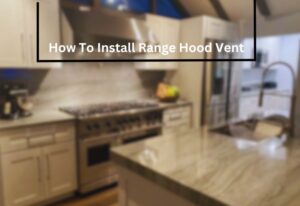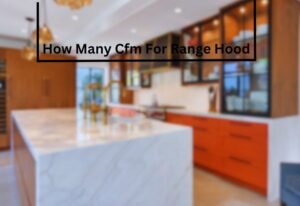Have you ever wondered if your range hood can touch your kitchen cabinets? It’s a common concern among homeowners who want to make sure their kitchen appliances and fixtures are not only functional but also aesthetically pleasing.
Can Range Hood Touch Cabinets? Yes, it’s essential to ensure that your range hood doesn’t touch the cabinets. The gap between them allows for proper ventilation and prevents heat and grease buildup, which can damage the cabinets over time. Be sure to follow the manufacturer’s installation guidelines to maintain a safe distance between your range hood and cabinets.
In this discussion, we’ll delve into the practical aspects of whether or not a range hood can come into contact with your cabinets. We’ll explore the reasons behind this concern, potential issues it may pose, and ways to ensure a harmonious coexistence between your range hood and cabinets. So, if you’re curious about this kitchen design dilemma, keep reading to find out more.
“The Close Encounter: Understanding the Clearance Requirements for Range Hoods and Cabinets”
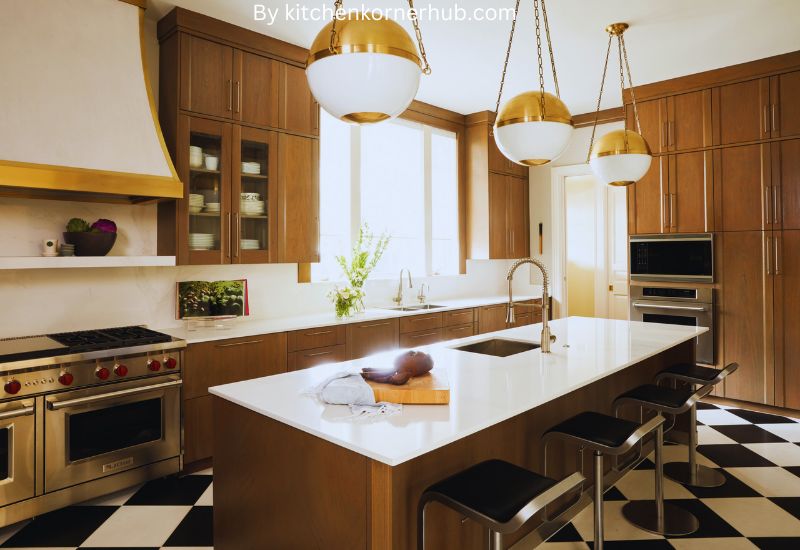
When it comes to designing and setting up your kitchen, there’s more to it than meets the eye. One crucial aspect to consider is the clearance requirements for range hoods and cabinets. In this note, we’ll break down the essentials of these requirements to help you create a functional and safe kitchen space.
Why Clearance Matters:
Clearance requirements are not just arbitrary rules; they play a significant role in ensuring your kitchen functions smoothly and safely. Adequate clearance around your range hood and cabinets prevents overheating, ensures proper ventilation, and minimizes the risk of accidents.
Range Hood Clearance:
Range hoods are essential for keeping your kitchen free of cooking odors and smoke. To ensure their effectiveness, maintain a minimum clearance of 24 to 30 inches between the cooking surface (like your stove) and the bottom of the range hood. This allows for efficient capture of airborne particles and fumes.
Cabinet Clearance Above the Stove:
The cabinets directly above your stove require careful consideration. Ideally, maintain at least 30 inches of space between the cooking surface and the bottom of the cabinets.
This prevents heat damage to the cabinets and minimizes the risk of grease buildup.
Side Clearance for Cabinets:
When placing cabinets adjacent to cooking appliances, ensure a minimum of 15 inches of clearance on either side.
This allows for safe operation and avoids potential fire hazards. Additionally, it ensures easy access to your cooking equipment.
Wall Clearance for Range Hoods:
For wall-mounted range hoods, maintain a clearance of 3 inches between the back of the hood and the wall. This space is necessary to allow for proper airflow and ventilation, ensuring that your range hood functions efficiently.
Island Range Hoods:
Island range hoods, suspended from the ceiling, require a different approach. Aim for at least 30 inches of clearance between the cooking surface and the bottom of the hood. This ensures effective capture of smoke and fumes in an open kitchen layout.
Customized Solutions:
Every kitchen is unique, and sometimes, standard clearance measurements might not fit your space.
In such cases, consider consulting with a kitchen designer or professional installer to create a customized solution that meets both safety and aesthetic requirements
“Seamless Kitchen Design: Exploring Range Hood Integration with Cabinetry”

In today’s quest for functional and aesthetically pleasing kitchen spaces, the integration of range hoods with cabinetry has emerged as a trend that effortlessly combines style and functionality.
This seamless kitchen design approach revolutionizes the way we perceive and utilize our kitchen environments. Let’s delve into this innovative concept with a closer look at its key aspects.
Harmonious Aesthetics:
The integration of range hoods with cabinetry offers a sleek and harmonious appearance in the kitchen. By concealing the hood within the cabinetry, it eliminates the visual clutter typically associated with traditional standalone range hoods.
This clean and cohesive look enhances the overall appeal of the kitchen, creating an inviting and uncluttered atmosphere.
Space Optimization:
Seamlessly integrating the range hood with cabinetry optimizes kitchen space. Traditional range hoods can consume valuable overhead space, making the kitchen feel smaller and less open.
With integrated designs, you gain more room for storage or decorative elements above your cooking area.
Enhanced Functionality:
While aesthetics are crucial, functionality remains paramount in kitchen design. Integrated range hoods maintain their effectiveness in ventilating cooking odors, smoke, and grease, just like their traditional counterparts.
This ensures that your kitchen remains a comfortable and odor-free space.
Customization Options:
Range hood integration allows for a high degree of customization. You can choose from a variety of materials, finishes, and styles for your cabinetry, ensuring that it perfectly matches your kitchen’s overall theme.
This flexibility empowers homeowners to create a unique and personalized culinary haven.
Noise Reduction:
Modern integrated range hoods often come equipped with advanced noise-reduction technology.
This innovation ensures a quieter cooking environment, allowing you to cook and converse without the distracting hum of a traditional hood.
Maintenance Simplification:
Cleaning and maintenance become more straightforward with integrated range hoods. The absence of exposed surfaces means fewer places for grease and grime to accumulate.
Additionally, removable filters are easily accessible, making regular cleaning hassle-free.
Energy Efficiency:
Integrated range hoods often feature energy-efficient options such as LED lighting and variable fan speeds. These not only reduce your energy consumption but also contribute to a greener, more sustainable kitchen.
“Navigating Kitchen Renovations: Ensuring Range Hoods and Cabinets Coexist Harmoniously”

Kitchen renovations can be both exciting and challenging endeavors. When it comes to creating a functional and aesthetically pleasing cooking space, ensuring that range hoods and cabinets coexist harmoniously is a crucial aspect.
Here, we’ll delve into some key considerations to help you successfully navigate this aspect of your kitchen remodel.
The Importance of Proper Planning:
Before diving into any kitchen renovation project, meticulous planning is essential. Take time to assess the available space, your cooking habits, and your design preferences. This initial step lays the foundation for a well-coordinated kitchen layout.
Selecting the Right Range Hood:
Choosing the appropriate range hood is pivotal. It should not only effectively remove cooking odors and smoke but also complement your kitchen’s style.
Wall-mounted, island, under-cabinet, and downdraft hoods are some common options, each with its unique benefits. Pick one that suits your cooking setup and design vision.
Measuring and Placement:
Accurate measurements are key when installing both range hoods and cabinets. Ensure the range hood’s dimensions align with your cooking area and do not interfere with cabinet installation. Pay attention to clearance requirements above the cooktop for proper ventilation.
Considering Ventilation Ducts:
If your range hood requires ventilation ducts, plan their route carefully. Ductwork should not obstruct cabinet installation or consume valuable storage space. Opt for ductless range hoods if you have limited options for duct installation.
Customization and Integration:
Custom cabinetry offers a seamless integration solution. Work with a professional kitchen designer or cabinet maker to create cabinets that accommodate the range hood’s size and design. Custom solutions ensure a cohesive look and efficient use of space.
Aesthetic Harmony:
Coordinating the aesthetics of your range hood and cabinets is essential for a visually pleasing kitchen. Choose complementary colors, materials, and finishes. Incorporate design elements that tie both components together, such as matching hardware or trim.
Functional Flow:
Lastly, prioritize functionality and workflow in your kitchen layout. Ensure that the placement of range hoods and cabinets facilitates easy access to cooking utensils, pots, and pans. An organized and ergonomic kitchen enhances your cooking experience.
“Space-Saving Solutions: Strategies for Range Hoods That Touch Cabinets”
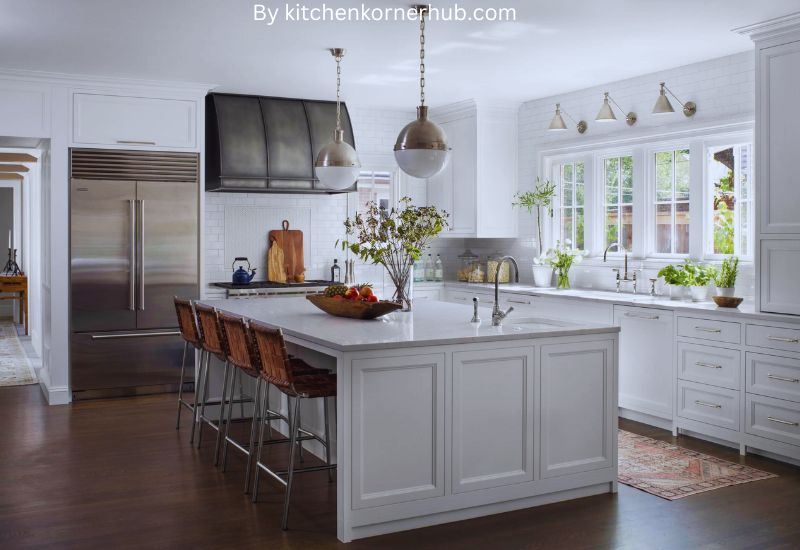
When it comes to designing a functional and aesthetically pleasing kitchen, every inch of space matters. One area that often poses a challenge is the placement of range hoods in close proximity to cabinets.
In this note, we’ll explore various strategies and space-saving solutions to make this combination work seamlessly in your kitchen.
Slim Profile Range Hoods:
Opting for slim-profile range hoods is an effective way to maximize space. These hoods are designed to be sleek and unobtrusive, allowing them to fit snugly between cabinets. They not only save space but also add a modern touch to your kitchen’s look.
Under-Cabinet Range Hoods:
Under-cabinet range hoods are specifically designed to be installed beneath cabinets. They’re an excellent choice if you have limited overhead space. These hoods effectively capture and vent cooking odors, keeping your kitchen fresh and odor-free.
Built-In Range Hoods:
For a truly seamless look, consider built-in range hoods that are integrated into the cabinets themselves. These hoods are concealed behind cabinet doors when not in use, maintaining a clean and cohesive appearance in your kitchen.
Telescopic Range Hoods:
Telescopic range hoods are a versatile solution that can be extended when needed and pushed back into the cabinet when not in use. This retractable design minimizes visual clutter and saves valuable cabinet space.
Ductless Range Hoods:
If ductwork installation is a challenge in your kitchen, ductless range hoods are a viable option. They use filters to purify the air and recirculate it back into the kitchen. This eliminates the need for extensive ductwork and opens up more cabinet space.
Wall-Mounted Range Hoods:
In kitchens with ample wall space, wall-mounted range hoods can be a practical choice. These hoods are mounted on the wall above the cooktop, leaving the space below the cabinets untouched. They are available in various styles to match your kitchen’s decor.
Custom Cabinetry Solutions:
For those looking to make the most of their kitchen space, custom cabinetry solutions can be tailored to accommodate range hoods seamlessly. Cabinet designers can create unique configurations that blend aesthetics and functionality, ensuring a perfect fit for your kitchen.
“Aesthetic Allure or Functional Foe? The Impact of Range Hood-Cabinet Contact”
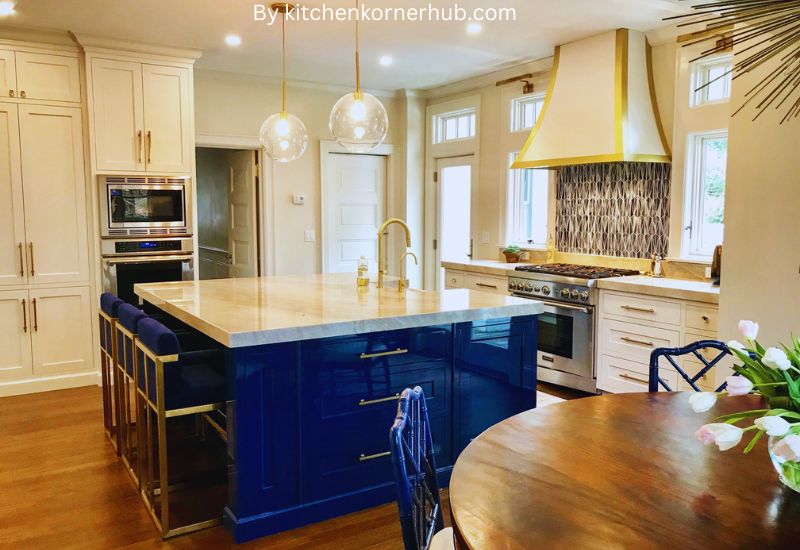
In the world of kitchen design, one often faces the dilemma of striking the perfect balance between aesthetics and functionality. One such crucial element in this quest is the range hood, and its interaction with kitchen cabinets can make or break the harmony of your culinary space.
The Aesthetic Harmony
Range hoods come in a variety of shapes, sizes, and finishes. They can be sleek and modern, rustic and charming, or seamlessly integrated into your cabinetry.
When the range hood and cabinets align seamlessly, it creates an aesthetically pleasing and cohesive look in your kitchen. This unity in design often becomes the focal point and elevates the overall ambiance.
The Space Factor
However, achieving this aesthetic allure may come at a functional cost. When range hoods are snugly nestled within cabinets, space can become an issue. Adequate clearance is necessary to ensure that the hood can effectively capture and vent cooking odors, steam, and grease.
A lack of clearance can hinder the range hood’s functionality and result in subpar performance.
Ventilation Efficiency
Proper ventilation is crucial in maintaining a clean and healthy kitchen environment. Range hoods are designed to remove airborne particles and maintain air quality. When cabinetry closely encroaches on the range hood, the ventilation efficiency can be compromised.
This can lead to lingering odors, moisture buildup, and even potential health concerns.
Cleaning and Maintenance
Another aspect to consider is the ease of cleaning and maintenance. Aesthetically pleasing designs often involve intricate detailing and concealed surfaces. While these may look stunning, they can be challenging to clean.
Grease and grime can accumulate in hard-to-reach areas, making regular maintenance a daunting task.
Noise Levels
Functionality also extends to noise levels. Range hoods vary in their noise output, and some quieter models may require more space for adequate sound insulation.
In a tightly integrated design, noise levels could become a concern, especially if your kitchen is an open space connected to other living areas.
Cost Considerations
Lastly, it’s essential to consider the cost implications. Customizing cabinetry to fit snugly around a range hood can be more expensive than a standard installation.
Additionally, maintenance costs for hard-to-reach areas and potential performance issues may incur additional expenses over time.
Conclusion
In conclusion, it’s vital to consider the clearance space when installing a range hood near cabinets. Safety is key! Range hoods can touch cabinets, but it’s essential to follow the manufacturer’s guidelines to prevent potential fire hazards. Adequate spacing and proper installation ensure that your kitchen remains safe and functional. So, go ahead and enjoy your cooking adventures with peace of mind, knowing you’ve got the right setup in your kitchen. Happy cooking!
Frequently Asked Question(Can Range Hood Touch Cabinets)
Can you put cabinets over range hood?
Yes, you can install cabinets over a range hood, but it’s essential to follow safety and clearance guidelines. The distance between the range hood and the bottom of the cabinets should meet local building codes and the manufacturer’s recommendations.
Typically, this clearance should be at least 24 to 30 inches to allow for proper ventilation and to prevent any fire hazards. Make sure to consult the installation manual of your specific range hood model and follow those instructions closely to ensure safe and efficient operation.
What is the disadvantage of range hood?
One of the disadvantages of a range hood is the noise it can generate while in operation. Range hoods use fans to draw in and vent out cooking odors, smoke, and grease. These fans can produce a noticeable amount of noise, which might be bothersome, especially in open kitchen designs where the noise can carry throughout the living space.
However, some range hoods come with quieter fan options or additional noise-reduction features to mitigate this issue. It’s crucial to consider the noise level when selecting a range hood for your kitchen.
Can you put a range hood anywhere?
In most cases, you cannot put a range hood just anywhere in your kitchen. Range hoods need to be installed directly above your cooking appliance, such as a stove or cooktop. They are designed to capture and remove cooking fumes, smoke, and odors right at the source.
Placing a range hood elsewhere in the kitchen won’t effectively accomplish this task. So, it’s essential to position your range hood directly over your cooking surface to ensure its proper functioning.
Can my range hood be smaller than my range?
Your range hood should ideally match the width of your range or cooktop. However, it can be smaller if necessary. It’s generally recommended that the range hood is slightly wider than the cooking surface to ensure effective coverage.
If your range hood is smaller than your range, it may still work, but it might not capture all the cooking fumes and odors as efficiently. Make sure to check the manufacturer’s recommendations for your specific range hood model to determine the minimum width requirement for optimal performance.


